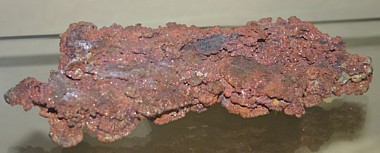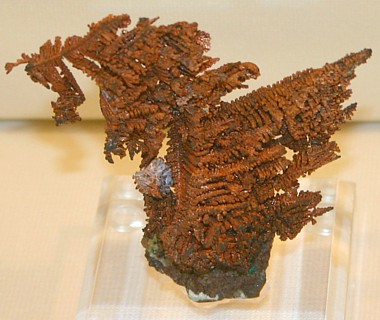
| COPPER MINERAL FACTS |  |
|
| The Gem and Mineral Collector's Photo Gallery by Nevada Outback |
|
. Copper Mineral Facts: Chemical Formula: Cu
Colors:
Copper Red
Hardness:
2.5 to 3 Density: 8.8 to 8.9 Cleavage: None Crystallography: Isometric Usually in irregular masses, plates, scales, etc., in twisted and wire like forms. Tetrahexahedron faces common on crystals. Also cube and dodecahedron. Groups of crystals are very common. Crystals usually distorted and in branching and arborescent groups, often they are skeleton crystals. In spite of its softness copper is better crystallized than either gold or silver. Luster:. Metallic luster. Optics: (Refractive Index): Opaque |
Above: Native Copper, Nevada |
|
 |
||
Identification and Diagnostics
Occurrence,
Localities and Origins: The copper that occurs in the upper portions of veins of copper sulfides is plainly of secondary origin. That which occurs in conglomerates and other fragmental rocks and in amygdaloids was evidently deposited by water, but whether by ascending magmatic water or by descending meteoric water is a matter of doubt.Localities. Native copper is found in Cornwall, England, in Nassau, Germany, in Bolivia, Peru, Chile and other South American countries, in the Appalachian region of the United States and in the Lake Superior region, both on the Canadian and the American sides. The most important district in the world producing native copper is on Keweenaw Point, in Michigan. The mineral occurs mainly in a bed of conglomerate of which it constitutes from 1 to 3 per cent, though it is found abundantly also in sandstone and in the amygdaloidal cavities of lavas associated with the conglomerates. Veins of calcite, through which groups of bright copper crystals are scattered are also very plentiful in many parts of the district. The copper is often mixed with silver in visible grains and patches. It is associated with such minerals as epidote, datolite, calcite and various zeolites. The mines were worked superficially by the Indians, and have been actively developed since the middle of the eighteenth century. Most of the copper of the district occurs in very small irregular specks, but notable large masses have been found, one weighing 420 tons being discovered in 1857.Sporadic occurrences of copper similar to that of the Lake Superior District have been found in the sandstone areas of the eastern United States, notably in New Jersey, and in the glacial drift overlying a similar area in Connecticut. Native copper occurs in small amounts, associated with the oxidized ores of Arizona, New Mexico and northern Mexico. Return to the Mineral Collectors Information Page |
Above: Copper Specimen, Michigan |
|
 |
||
Please note that the author, Chris Ralph, retains all copyrights to this entire document and it may not be reproduced, quoted or copied without permission.

NEVADA OUTBACK GEMS TURQUOISE AND JEWELRY